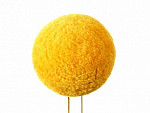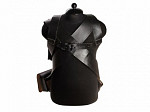| Artikul: 107064 |
|
||
Russian Imperial Guards Grenade eagle shako hat model 1812 Napoleonic Wars period
War Of 1812 high-quality leather Shako Guards Grenadier Regiments of the Russian Imperial Army & Guards shako (Chako, czako, schako, tschako).
Material - body covered with black felt. Completed with:
- NCO etishket (cord) with tassels on shako,
- State seal Eagle cockade,
- chin scales. Chain made of high bright quality brass.
- plume.
Fits up to sizes 61cm (US 7 5/8) with adjustment.
Copy of best quality, all the correct materials.
Reference.
The word shako originated from the Hungarian name csákós süveg ("peaked cap"), which was a part of the uniform of the Hungarian hussar of the 18th century. Other spellings include chako, czako, schako and tschako.
From 1800 on the shako became a common military headdress, worn by the majority of regiments in the armies of Europe and the Americas. Replacing in most instances the light bicorne, the shako was initially considered an improvement. Made of heavy felt and leather, it retained its shape and provided some protection for the soldier's skull, while its visor shaded his eyes. The shako retained this pre-eminence until the mid-19th century, when spiked helmets began to appear in the armies of the various German States, and the more practical kepi replaced it for all but parade wear in the French Army.
The Imperial Russian Army substituted a spiked helmet for the shako in 1844-45 but returned to the latter headdress in 1855, before adopting a form of kepi in 1864. Following the Franco-Prussian War of 1870, military fashions changed and cloth or leather helmets based on the German headdress began to supersede the shako in many armies.


War Of 1812 high-quality leather Shako Guards Grenadier Regiments of the Russian Imperial Army & Guards shako (Chako, czako, schako, tschako).
Material - body covered with black felt. Completed with:
- NCO etishket (cord) with tassels on shako,
- State seal Eagle cockade,
- chin scales. Chain made of high bright quality brass.
- plume.
Fits up to sizes 61cm (US 7 5/8) with adjustment.
Copy of best quality, all the correct materials.
Reference.
The word shako originated from the Hungarian name csákós süveg ("peaked cap"), which was a part of the uniform of the Hungarian hussar of the 18th century. Other spellings include chako, czako, schako and tschako.
From 1800 on the shako became a common military headdress, worn by the majority of regiments in the armies of Europe and the Americas. Replacing in most instances the light bicorne, the shako was initially considered an improvement. Made of heavy felt and leather, it retained its shape and provided some protection for the soldier's skull, while its visor shaded his eyes. The shako retained this pre-eminence until the mid-19th century, when spiked helmets began to appear in the armies of the various German States, and the more practical kepi replaced it for all but parade wear in the French Army.
The Imperial Russian Army substituted a spiked helmet for the shako in 1844-45 but returned to the latter headdress in 1855, before adopting a form of kepi in 1864. Following the Franco-Prussian War of 1870, military fashions changed and cloth or leather helmets based on the German headdress began to supersede the shako in many armies.
Buy Set
Общая стоимость выбранных товаров
138 400 RUB
Buy

Кивер образца 1812 года (с "развалом" и унтер-офицерским этишкетом). Россия, копия
130 000 RUB

5 400 RUB
Кивер образца 1812 года (с "развалом" и унтер-офицерским этишкетом). Россия, копия | ||
| Artikul: 107064 |
|
|




